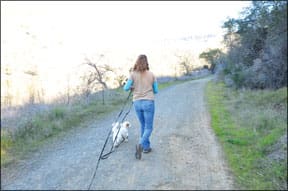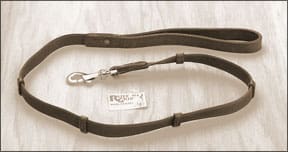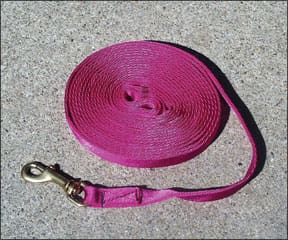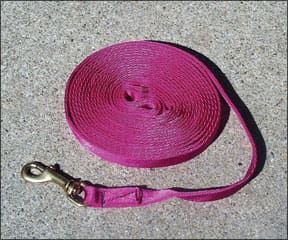When you think “leash,” chances are you think of a four-to-six-foot strap made of nylon, cotton, hemp, leather, or (horrors!) chain, with a snap that attaches to your dog’s collar at one end and a handle for you to hold at the other. You use it to keep him close to you when you take him for walks or other places where he has to be under control. But a leash can be so much more than that!

288
Let’s think outside the box. There’s no law that says leashes have to be a certain length, made of a particular material, or be limited to one snap and one handle. There are all kinds of things you can do with non-traditional leashes. Heck, there’s even a good use for the grocery store chain leash.
Long and Short Of It
It’s true that four to six feet is a good length for normal leash-walking. That’s long enough that you can leave slack in the leash, as is desirable when your dog is walking politely by your side, but short enough you don’t have a large wad of leash-spaghetti in your hands when you want to gather it up so no one steps on it. However, shorter can be good sometimes. So can longer. The following are descriptions of some other useful leash lengths, and what they have to offer.
–Tab: A tab is a three-to-six inch bit of leash that makes it easier to snag your dog in a hurry, if necessary, without grabbing for his collar – a move that many dogs consider rude or intimidating, and that sometimes can elicit aggression. You can leave a tab on your dog at home to corral him easily if the doorbell rings, or make it easier on all parties if he gets tense when you reach for him for any husbandry or management purposes. Sure, you’d like to desensitize him to collar grabs (see “Stay in Touch,” February 2011), but in the meantime a tab can keep you both happy.
A tab can also be useful at an off-leash training class, or at the dog park – again, if you want to quickly get him under control with minimum tension. Agility people use them a lot.
You can buy tabs commercially; I like the ones from sitstay.com (800-748-7829). Or simply cut an old leash to the desired three to six inches. You can also make one from scratch. The more tense your dog is about having his collar grasped, the longer you might want to make your tab.
Note: The tab should be removed from your dog’s collar for safety reasons when he’s not under your direct supervision.
–Drag line: A drag line serves a similar purpose as the tab, only more so. This is a four-to-six-foot (or longer) light line that stays attached to your dog’s collar when he’s in the house. You can step on it to prevent your dog from dashing out the door, jumping up to greet a guest, “surfing” the counter, or leaping onto an off-limits piece of furniture. Or, step on it to interrupt a game of keep-away when he has something he shouldn’t (after which you cheerfully trade him something wonderful for the forbidden object, of course.) You can probably think of additional uses for your own canine challenges – perhaps gently inviting your uncooperative pal out from under the bed. Drag lines are available commercially in strong, light materials such as parachute cord (petexpertise.com; 888-473-8397) or you can make your own. Remember to remove the line from your dog’s collar when no one is home to supervise!

288
–Long line or light line: These can run anywhere from 15 to 50 feet, and are for outdoor use. They are most frequently used for teaching reliable recalls at increasing distances (see “A Line on Insurance” on the next page). But they can also be used as an outdoor dragline for backup insurance when you’re not quite sure about your dog’s recall, and to give your dog more hiking freedom when you know you can’t yet trust his recall.
The long line is generally heavier – flat nylon or cotton canvas or marine rope – while the light line is usually parachute cord or some other strong nylon. (I like the ones from genuinedoggear.com; 813-920-5241.)
It takes some skill to manage long and light lines without turning them into a knotted mess, but it’s worth the effort. Although popular because they offer the easy convenience of self-rewinding, retractable leads have far too many drawbacks to be considered a viable training tool.
Caution: If you’re using your long line or light line as a drag line and your dog runs off, he can get tangled around trees and brush and need rescuing because he won’t be able to return to you. Be careful!
Design Makes a Difference
Is there a better mousetrap in the world of leashes? It all depends on what your needs are. A standard leash is certainly the workhorse of the leash-walking set, but there are others that just might be perfect for you and your dog. We’re not talking about the endless variety of designer colors and patterns to match every outfit and holiday; we’re talking function here.
There are couplers that let you walk two dogs without tangling leashes. Leashes that attach your dog to your bicycle. Leashes with two handles, one near the collar, that give you instant control if you suddenly need it (like the ones from fetchdog.com; 800-595-0595). There are hands-free/multi-function leashes that can change length or double as a coupler or a tether (thedogoutdoors.com; 513-703-0210), and non-slip grip leashes that give you added traction, even in the rain. (Check out the ones from ruffgrip.com; 800-547-3966. I’ve had one of these for a long time and love it!)
Agility folks even use special leashes that have been designed to contain their dog’s special reinforcers: tug toys! Clean Run (cleanrun.com; 800-311-6503) has a whole line of leashes that are designed for tugging.
Don’t forget the T-Touch Balance leash, with a snap at each end and a handle in the middle on a sliding ring so you can attach it to a collar and a harness (available from ttouch.com; 866-488-6824). You use the two ends of the leash almost like reins on a horse, to send subtle, gentle communications to your dog. A similar leash sold by Wiggles, Wags & Whiskers with their Freedom No-Pull Harness functions the same way (wiggleswagswhiskers.com, 866-944-9247).

288
Speaking of no-pull and thinking outside the box, here’s a handy tip: You can take that basic six-foot leash (any material other than chain), attach it to your dog’s collar, run it from the back of his neck, down behind the elbow, under his rib cage and up the other side, slip it under the leash where the clip is, around the front of his chest and bring it up under the leash on the other side, and you have an instant emergency no-pull harness.
Material World
Nylon, cotton, hemp, and leather are the materials most commonly used for training leashes. Some trainers prefer leather because it is less abrasive to your hands if your dog pulls. Nylon leashes tend to be the least expensive, with cotton and hemp close behind.
Long lines and light lines tend to be made of parachute cord and other light-but-strong nylon fibers. You can find cotton long lines, but some people complain about how heavy cotton gets when it gets wet (as when it gets dragged through wet grass).
Chain leashes have the most potential to cause significant injury to your hands. However they do have a narrow niche in a training toolbox: they can be useful for dogs who chew on (or chew through) their leather or fabric leashes.
Chain leashes can also be used to discourage a dog who tries to tug on his leash when you prefer that he not. With a non-chain leash, when you resist your dog’s pulling (you can’t just drop the leash and let him go!) he gets reinforced for his inappropriate leash behavior (it’s fun!) – so his leash tugging and chewing may persist and even increase. Most dogs find biting on metal chain mildly aversive, so they learn to keep their teeth off their leash while you work to reinforce more appropriate behaviors.
The other critically important piece of your leash or long line is the snap. You want a leash with quality hardware that won’t rust, corrode, freeze up, or otherwise fail you in an emergency. The last thing you need is a snap that pops open or breaks at the exact instant your dog reaches the end of it. Extra soft, strong, nylon webbing leashes and long lines fitted with very sturdy brass hardware are available from White Pine Outfitters (whitepineoutfitters.com; 715-372-5627).
It’s well worth spending more for well-designed, good quality leash equipment that can last the life of your dog, and might save your dog’s life one day. One of my favorites is the well-made 30-foot light line at Genuine Dog Gear. At $22.95, that’s less than $1.50 per year for a dog who lives to be 15, or four tenths of a cent per day. Another is the 50-foot soft web long line from White Pine Outfitters. At $55.60 that’s still only $3.70 per year, or a penny a day. Isn’t he worth at least that?







Average dog leash is six foot it’s important news for any dog lovers for choosing leash.
Thank you